Recycled stone surfaces offer enhanced durability and eco-friendliness for laboratory environments, while soapstone provides superior chemical resistance and heat tolerance. Choosing between recycled stone and soapstone depends on balancing sustainability with performance requirements in laboratory applications.
Table of Comparison
| Feature | Recycled Stone | Soapstone |
|---|---|---|
| Composition | Crushed stone fragments bound with resin | Natural talc-rich metamorphic rock |
| Durability | High impact and scratch resistance | Moderate hardness, prone to scratching |
| Chemical Resistance | Excellent resistance to acids and solvents | Good resistance, may etch with strong acids |
| Heat Resistance | Moderate, avoid direct high heat | High heat resistance, safe for lab use |
| Maintenance | Low maintenance, easy to clean | Requires periodic oiling to maintain surface |
| Environmental Impact | Eco-friendly, made from recycled materials | Natural material, limited environmental impact |
| Cost | Moderate, varies by resin quality | Higher, due to natural stone sourcing |
Introduction to Laboratory Surface Materials
Laboratory surfaces require materials with excellent chemical resistance, durability, and ease of maintenance, making recycled stone and soapstone popular choices. Recycled stone offers environmental benefits and high strength by combining crushed stone with resin binders, while soapstone provides natural resistance to acids and heat due to its dense talc composition. Selecting between recycled stone and soapstone depends on specific laboratory needs such as exposure to chemicals, physical wear, and sustainability priorities.
Overview of Recycled Stone for Labs
Recycled stone for laboratory surfaces offers a sustainable and durable alternative by combining crushed stone, glass, and resin to create a resilient material resistant to chemicals and heat. This eco-friendly composite provides excellent impact resistance and low porosity, minimizing stain absorption and making maintenance easier in high-use lab environments. Compared to natural soapstone, recycled stone surfaces often deliver enhanced versatility, reduced environmental impact, and competitive cost efficiency for laboratory benchtops.
Key Properties of Soapstone in Laboratories
Soapstone offers exceptional chemical resistance and thermal stability, making it ideal for laboratory surfaces exposed to acids, bases, and heat. Its non-porous structure prevents absorption of liquids and stains, ensuring easy cleaning and durability in aggressive environments. Compared to recycled stone, soapstone's superior softness allows for easy machining and customization without compromising structural integrity.
Durability: Recycled Stone vs. Soapstone
Recycled stone surfaces offer high durability through enhanced impact resistance and improved scratch resistance compared to traditional soapstone, making them well-suited for demanding laboratory environments. Soapstone is naturally non-porous and chemically stable but can be softer, leading to potential scratching and minor surface wear over time. Laboratories prioritizing long-term surface integrity often favor recycled stone for its superior toughness and resistance to common laboratory chemicals.
Chemical Resistance Comparison
Recycled stone surfaces offer moderate chemical resistance suitable for everyday lab use but can be more porous and susceptible to staining from strong acids and bases. Soapstone exhibits superior chemical resistance due to its dense talc composition, making it highly resistant to acids, alkalis, and solvents commonly encountered in laboratories. This durability combined with its non-porous nature ensures soapstone remains a preferred choice for chemical-heavy environments needing robust surface protection.
Maintenance and Cleaning Requirements
Recycled stone surfaces in laboratories require minimal maintenance due to their non-porous nature, resisting stains and chemical damage, which simplifies routine cleaning with mild detergents and water. Soapstone demands more careful upkeep, as it is softer and susceptible to scratches and etching, necessitating regular oiling to maintain its surface integrity and occasional resealing to prevent staining. Choosing recycled stone enhances long-term durability and reduces cleaning frequency, making it a practical choice for high-traffic laboratory environments.
Environmental Impact and Sustainability
Recycled stone surfaces significantly reduce landfill waste and lower the demand for virgin raw materials, enhancing sustainability in laboratory settings. Soapstone, a natural material, is highly durable and non-porous but requires quarrying that can disrupt ecosystems and consume energy. Opting for recycled stone promotes circular economy principles, while soapstone's longevity offers a balance between environmental impact and functional lifespan in laboratories.
Cost Analysis: Recycled Stone vs. Soapstone
Recycled stone surfaces typically offer a more cost-effective solution compared to soapstone for laboratory countertops, with prices often 20-40% lower due to the use of repurposed materials and reduced processing expenses. Soapstone provides superior chemical resistance and durability, but these benefits come at a higher initial investment, frequently ranging from $70 to $100 per square foot. Considering long-term maintenance and replacement costs, recycled stone can present significant savings, making it an attractive option for budget-conscious laboratory setups.
Aesthetic and Design Considerations
Recycled stone offers a unique aesthetic with its varied texture and color patterns derived from repurposed materials, creating an eco-friendly yet visually appealing laboratory surface. Soapstone presents a smooth, matte finish with natural veining that lends a classic and elegant look, favored for its timeless design and subtle color variations. Both materials provide versatile design opportunities, but recycled stone excels in distinctiveness while soapstone emphasizes consistent, refined beauty.
Choosing the Right Laboratory Surface Material
Recycled stone offers excellent durability and environmental benefits with high resistance to chemicals, making it suitable for eco-conscious laboratories seeking sustainable surfaces. Soapstone provides superior heat resistance and natural chemical inertness, ideal for labs where thermal stability and non-reactivity are critical. Choosing between recycled stone and soapstone depends on prioritizing sustainability and hardness versus heat tolerance and chemical inertness for optimal laboratory functionality.

Infographic: Recycled stone vs Soapstone for Laboratory surface
 azmater.com
azmater.com